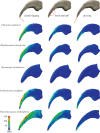Morphological and functional diversity in therizinosaur claws and the implications for theropod claw evolution
- PMID: 24807260
- PMCID: PMC4024305
- DOI: 10.1098/rspb.2014.0497
Morphological and functional diversity in therizinosaur claws and the implications for theropod claw evolution
Abstract
Therizinosaurs are a group of herbivorous theropod dinosaurs from the Cretaceous of North America and Asia, best known for their iconically large and elongate manual claws. However, among Therizinosauria, ungual morphology is highly variable, reflecting a general trend found in derived theropod dinosaurs (Maniraptoriformes). A combined approach of shape analysis to characterize changes in manual ungual morphology across theropods and finite-element analysis to assess the biomechanical properties of different ungual shapes in therizinosaurs reveals a functional diversity related to ungual morphology. While some therizinosaur taxa used their claws in a generalist fashion, other taxa were functionally adapted to use the claws as grasping hooks during foraging. Results further indicate that maniraptoriform dinosaurs deviated from the plesiomorphic theropod ungual morphology resulting in increased functional diversity. This trend parallels modifications of the cranial skeleton in derived theropods in response to dietary adaptation, suggesting that dietary diversification was a major driver for morphological and functional disparity in theropod evolution.
Keywords: Theropoda; finite-element analysis; functional morphology; shape analysis.
Figures



References
-
- Clark JM, Maryanska T, Barsbold R. 2004. Therizinosauroidea. In The Dinosauria (second edition) (eds Weishampel DB, Dodson P, Osmolska H.), pp. 151–164. Berkeley, CA: University of California Press.
-
- Barsbold R. 1976. New data on Therizinosaurus (Therizinosauridae, Theropoda). Transactions, Joint Soviet–Mongolian Paleontological Expedition 3, 76–92. [In Russian.]
-
- Zanno LE. 2010. A taxonomic and phylogenetic re-evaluation of Therizinosauria (Dinosauria: Maniraptora). J. Syst. Palaeontol. 8, 503–543. (10.1080/14772019.2010.488045) - DOI
-
- Paul GS. 1984. The segnosaurian dinosaurs: relics of the prosauropod–ornithischian transition? J. Vertebrate Paleontol. 4, 507–515. (10.1080/02724634.1984.10012026) - DOI
Publication types
MeSH terms
LinkOut - more resources
Full Text Sources
Other Literature Sources

